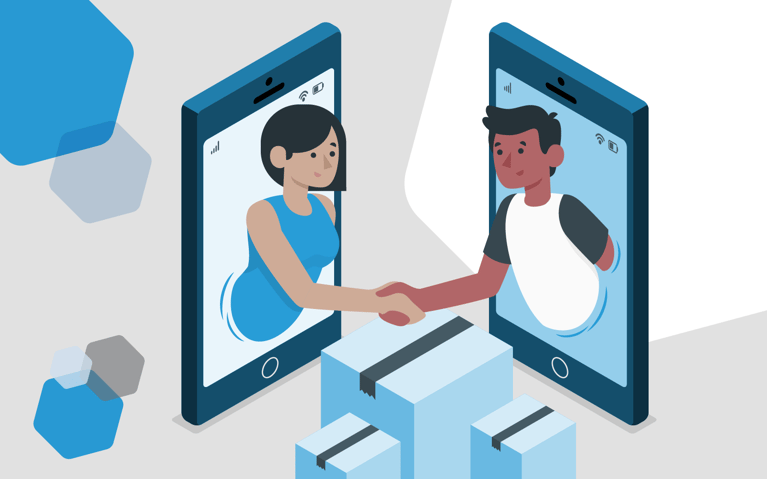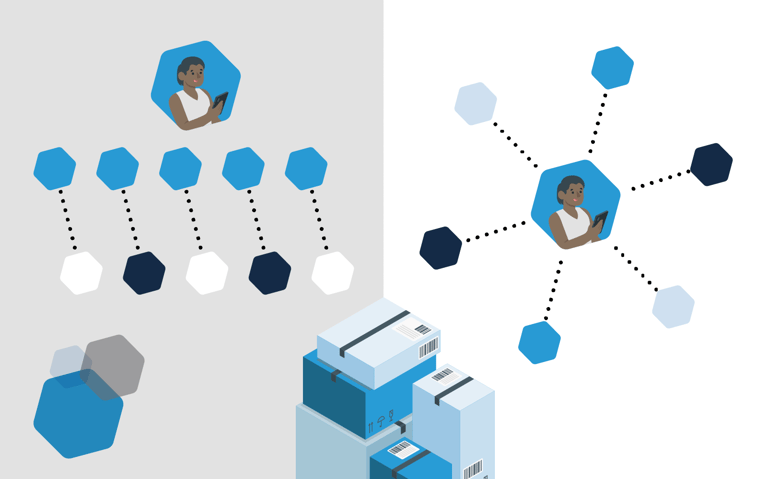Efficient, real-time omnichannel fulfillment has become critical for retailers and B2B retailers. The ability to seamlessly integrate online and offline sales channels enhances customer satisfaction and unifies retail operations, ensuring that businesses remain competitive. To optimize fulfillment operations in an omnichannel world, you must explore strategies for integrating various sales channels, use tips for optimizing the customer journey and experience and learn how to leverage the expertise of a third-party logistics (3PL) provider. With the proper knowledge, you can create a cohesive, efficient omnichannel strategy that unifies both online and offline sales channels, allowing you to streamline your retail and fulfillment operations.
Omnichannel fulfillment’s importance in modern retail operations
Definition: Omnichannel fulfillment is an integrated approach of managing and delivering orders across multiple sales channels – both online and offline. This strategy provides a seamless shopping experience for customers, whether they are purchasing through an ecommerce website, mobile app, physical store or a combination of these.
Importance: Adopting an omnichannel strategy offers numerous benefits for retail brands. It enhances customer satisfaction by providing flexible shopping and delivery options, boosts sales by reaching a wider audience and improves inventory management by synchronizing stock levels across all channels. For example, a customer might order a product online and pick it up in-store or return an in-store purchase via mail. This flexibility not only meets consumers' evolving expectations but also strengthens brand loyalty.
Challenges: Despite its advantages, omnichannel fulfillment poses several challenges. Coordinating inventory across multiple platforms can be complex, leading to potential stock discrepancies. In addition, ensuring consistent customer service and experience across all channels requires substantial effort and resources. Retailers might struggle with integrating their online and offline systems and managing logistics efficiently to meet customer expectations for fast and reliable delivery. By recognizing these challenges, retail brands can develop strategies to overcome them and fully leverage the benefits of omnichannel fulfillment.
Integrating online and offline sales channels
Integrating online and offline sales channels is essential for a successful omnichannel strategy for retail brands. Achieving seamless integration requires unified inventory management, efficient order processing and a consistent customer experience. You can take several steps to integrate your sales channels and optimize your omnichannel fulfillment operations.
Unify inventory management
Real-time inventory visibility is crucial for any omnichannel strategy. It ensures that both your online and offline channels reflect accurate stock levels, preventing overselling and underselling. With real-time data, you can make informed decisions about restocking, transferring inventory between locations and fulfilling customer orders efficiently. For instance, if a product is out of stock online but available in a nearby store, real-time visibility allows you to offer customers the option to pick up in-store, thereby capturing sales that might otherwise be lost.
Several tools and technologies can help achieve unified inventory management. Systems like Enterprise Resource Planning (ERP) software, Warehouse Management Systems (WMS) and Order Management Systems (OMS) can integrate seamlessly with your sales platforms. These tools offer functionalities such as automatic stock updates, demand forecasting, and inventory optimization, helping to streamline your operations and improve efficiency.
Create frictionless order processing
For a smooth order processing experience, you must have a unified order management system that consolidates orders from all sales channels. This system should be capable of routing orders to the most appropriate fulfillment center based on factors like inventory levels and proximity to the customer. Automation tools can significantly reduce manual errors and speed up the processing time.
Brands should also implement best practices such as establishing clear picking and packing processes, using barcode scanning for accuracy and having a robust returns management system. Regular staff training and continuous improvement can further enhance efficiency.
Develop a consistent customer experience
Consistency in branding and customer experience across all sales channels is vital for building trust and loyalty. This means that whether customers interact with your brand online or in-store, they should have a seamless and cohesive experience. Uniform messaging, visual elements and customer service standards across channels help maintain a strong brand identity. For example, Apple’s stores and online presence offer a consistent experience, with the same products, design aesthetic and customer service quality, reinforcing their brand image.
Personalized customer experiences can also set your brand apart. Utilizing customer data from various touchpoints allows you to tailor marketing messages, recommendations, and services to individual preferences. Tools like Customer Relationship Management (CRM) systems and advanced analytics can help gather and analyze customer data to deliver personalized experiences. Nordstrom, for instance, uses customer data to personalize online and in-store shopping experiences, offering product recommendations and customized services based on past purchases and preferences.
By effectively integrating online and offline sales channels, utilizing advanced tools for inventory management, streamlining order processing and ensuring a consistent and personalized customer experience, retail brands can optimize their omnichannel fulfillment efforts and enhance their overall retail operations.
Technology solutions for omnichannel fulfillment
Technology solutions are the key to effective omnichannel fulfillment. The software brands should consider include:
- Order Management System (OMS) software: Your OMS plays a central role in omnichannel fulfillment by coordinating orders across various channels. Modern, robust OMS software ensures accurate order processing, inventory tracking and allows you to unify commerce through seamless integration with other systems. Key features to look for in an OMS include real-time inventory updates, multi-channel order routing, location orchestration, predictive order and inventory AI and automated fulfillment workflows.
- Warehouse Management Systems (WMS): A WMS is essential for optimizing fulfillment operations within a warehouse. It helps manage inventory, picking and packing and shipping processes efficiently. WMS and OMS integration with other systems can accurately track and update inventory levels in real-time. These integrations can significantly reduce errors and improve the speed of order fulfillment. For instance, a well-integrated WMS can enable faster order processing by directing warehouse staff to the exact location of the items in real-time. Emerging fulfillment software features a suite of solutions in one, including your OMS, WMS and TMS (transportation management system) software.
- Customer Relationship Management (CRM): CRM systems support omnichannel strategies by providing a unified view of customer interactions across all channels. This helps personalize the shopping experience and improve customer satisfaction. Benefits of using CRM in omnichannel fulfillment include better customer segmentation, targeted marketing campaigns and improved customer service. It also helps you optimize the post-purchase experience. A CRM system can track customer preferences and purchase history, allowing retail brands to tailor their communication and offers to individual customers, enhancing the end-to-end journey.
How a 3PL supports your omnichannel needs
Partnering with a third-party logistics (3PL) provider for omnichannel fulfillment offers retail and B2B brands several advantages.3PLs bring expertise and specialized knowledge in logistics, helping to streamline operations and improve efficiency. They can provide advanced technology and systems, such as integrated Order Management Systems (OMS) and Warehouse Management Systems (WMS), which enhance inventory accuracy and order processing speed.
Additionally, 3PLs provide scalability, allowing retailers to easily adjust their logistics capacity to meet fluctuating demand, especially during peak seasons. By leveraging the extensive distribution networks and resources of a 3PL, retail brands can expand their reach and improve delivery times, boosting customer satisfaction. Managing the labor, partnerships and budget of self-fulfillment can be complex: Partnering with a 3PL reduces the burden of managing logistics in-house, freeing up resources and allowing retailers to focus on their core competencies.
Contact our team today to learn more about Cart.com’s solutions and services that unify commerce and support brands from discovery to delivery.
Subscribe to our emails for the latest industry insights!
By entering your email, you agree to receive marketing emails from Cart.com








